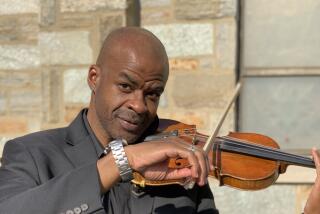Violist Helps to Dispel Instrument’s Obscurity
SAN DIEGO — The wag who coined the phrase “playing second fiddle” might have been more accurate in describing the state of forlorn subordination if he had said “playing viola.” But the instrument’s general obscurity probably would have prevented the phrase from entering the vernacular.
Violist Karen Elaine dispelled some of her instrument’s anonymity in a well-constructed recital Wednesday evening at San Diego State University’s Smith Recital Hall. On the program’s first half, the SDSU faculty member offered four varied orchestral works in her own arrangements for solo viola and string quartet.
Norman Dello Joio’s “Lyric Fantasies” showed Elaine’s abilities in the most favorable light, pitting her fluid, assured line against the solid counterpoint of the accompanying Rinaldi String Quartet.
Elaine propelled her solo lines with the sweet tone and drive appropriate to the work’s panache and unabashedly tonal idiom (it was written in 1973).
Elaine’s least successful arrangement was an adaptation of Paganini’s Caprice No. 24, Op. 1. Although she made a laudable case for using viola instead of violin as the Caprice’s solo instrument, she did not survive every variation unscathed, and the accompaniment required more weight than Rinaldi was able to supply. The outer movements, however, emerged as impressive technical showpieces for the soloist.
Elaine displayed a warm timbre and fluent sense of Baroque style in Vivaldi’s three-movement Viola Concerto in A Major. Her romanticized approach to Veracini’s “Largo in F-sharp Minor,” however, made the stark work more ponderous than it needed to be.
In the Veracini and in the middle movement of the Vivaldi, Elaine battled with minor intonation problems, notably appoggiaturas just under pitch.
After the intermission, Elaine joined the Rinaldi Quartet (of which she is a regular member) in three crossover pieces. With the Kronos Quartet’s regular forays into pop music and the Turtle Island Quartet’s jazz repertory, Rinaldi’s lighter offerings were hardly shocking.
A jazzy, robust piece called “Don and Dewey” by Laflamme invited a second hearing. The pop syncopations of “Standard Equipment” by Stephen Ball, Rinaldi’s first violinist, soon wore thin. Ball gave himself a plethora of flashy solos while his colleagues noodled.
Although the particular pop style of “Standard Equipment” remained elusive to this reviewer, the comment of two undergraduate audience members, “It sounded like a theme song for a movie,” was not far from the mark.
The second Ball opus, “Moonblossom,” offered graceful themes and impressionistic harmonies in a New Age idiom that was not at all soporific.
The other members of the Rinaldi Quartet are violinist Anna Ball and cellist Jennifer Holson. On the program’s first half, violinist Kathleen Simmons joined the ensemble.
More to Read
The biggest entertainment stories
Get our big stories about Hollywood, film, television, music, arts, culture and more right in your inbox as soon as they publish.
You may occasionally receive promotional content from the Los Angeles Times.










